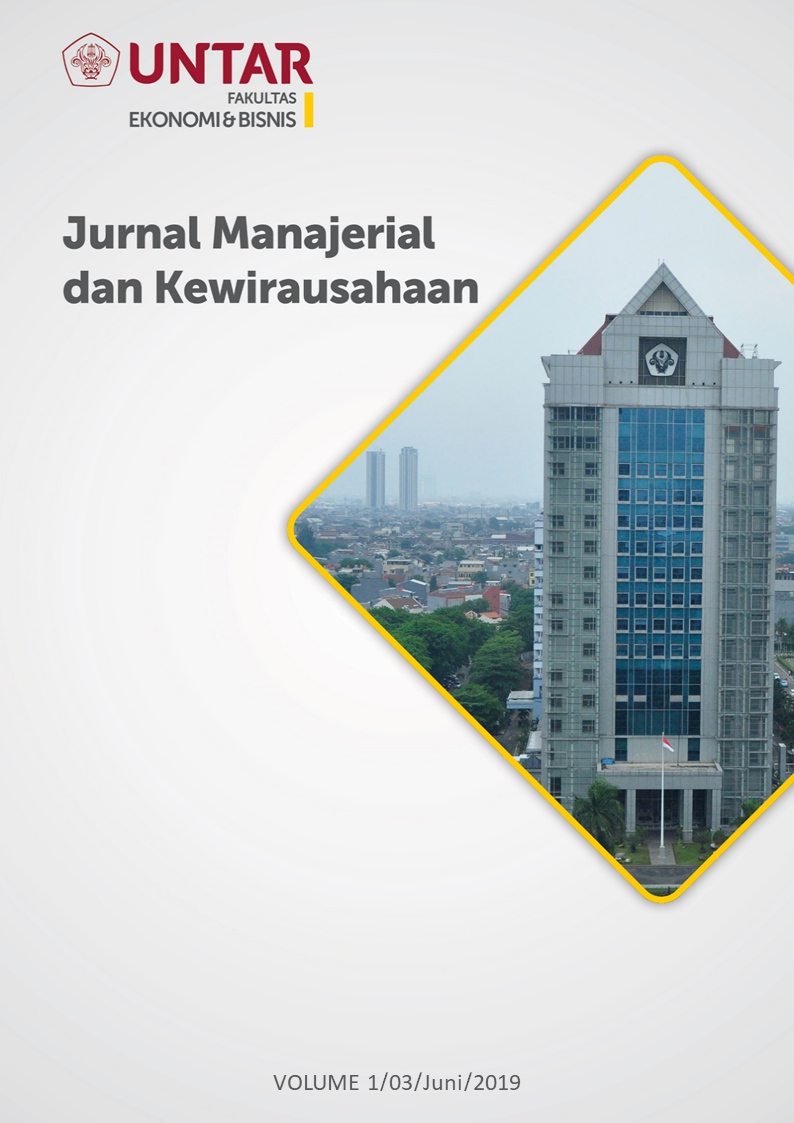Pengaruh Optimisme Kewirausahaan Yang Dimoderasi Oleh Gaya Kognitif Terhadap Ketekunan Kewirausahaan UKM Bidang Kuliner Di Jakarta Barat
Main Article Content
Abstract
The purpose of this study was to analyze the influence of Entrepreneurial optimism on entrepreneurial perseverance, and whether entrepreneurial optimism can be moderated by cognitive style towards entrepreneurial perseverance. This study uses a quantitative method where data is collected by researchers through surveys directly to prospective respondents by giving questionnaires to 60 SME respondents in the culinary field in West Jakarta. The data analysis method used by the researcher was SEM which was calculated through SmartPLS 3 software with the bootstrapping method to measure the significance level. The results showed that entrepreneurial optimism had an influence on entrepreneurial perseverance, but for cognitive styles that moderated the relationship of entrepreneurial optimism with entrepreneurial perseverance it produced negative results
Tujuan penelitian ini adalah untuk menganalisis pengaruh optimisme kewirausahaan terhadap ketekunan kewirausahaan, dan apakah optimisme kewirausahaan dapat dimoderasi oleh gaya kognitif terhadap ketekunan kewirausahaan. Penelitian ini menggunakan metode kuantitatif dimana data dikumpulkan oleh peneliti melalui survei secara langsung kepada calon responden dengan memberikan kuesioner terhadap 60 responden UKM bidang kuliner di Jakarta Barat. Metode analisis data yang digunakan oleh peneliti adalah SEM yang dikalkulasi melalui perangkat lunak SmartPLS 3 dengan metode bootstrapping untuk mengukur tingkat signifikansinya. Hasil penelitian menunjukkan bahwa optimisme kewirausahaan memiliki pengaruh terhadap ketekunan kewirausahaan, namun untuk gaya kognitif yang memoderasi hubungan optimisme kewirausahaan dengan ketekunan kewirausahaan mengasikan hasil yang negatif.
Article Details
This work is licensed under a Jurnal Muara Ilmu Ekonomi dan Bisnis Creative Commons Attribution-ShareAlike 4.0 International License.,/p>
References
Adomako, S., Danso, A., Uddin, M., and Ofori-Damoah, J. (2015). Entrepreneurs’ optimism
cognitive style and persistence. Journal of Entrepreneurial Behavior & Research,
, 22(3), 290-328.
Amirullah. (2015). Metode Penelitian Manajemen. Malang; Batumedia Publishing Malang. 67-
Arikunto, Suharsimi. 2010. Prosedur Penelitian Suatu Pendekatan Praktek. Edisi Revisi 2010.
Jakarta: Rineka Cipta.
Batra, S., and Vohra, N. (2016). Exploring the linkages of cognitive style and individual
innovativeness. Management Research Review, 39(7), 768-785.
Baum, J.R., and Locke, E.A. (2004). The relationship of entrepreneurial traits, skill, and
motivation to subsequent venture growth. Journal of Applied Psychology, 89(4), 587-
Brown, J.D., and Marshall, M.A. (2001). Great expectations: optimism and pessimism in
achievement settings. Optimism and Pessimism: Implications for Theory, Research,
and Practice, American Psychological Association, Washington, DC, 239-255..
Burke, L.A. and Miller, M.K. (1999). Taking the mystery out of intuitive decision making.
Journal Academy of Management Executive, 1999, 13 (4), 91-99.
Busenitz, L.W. (1999). Entrepreneurial risk and strategic decision-making: it’s a matter of
perspective. The Journal of Applied Behavioral Science, 35 (4), 325-340
Cardon, M.S., and Kirk, C.P. (2015). Entrepreneurial passion as mediator of the self-efficacy
to persistence relationship. Entrepreneurship Theory and Practice, 39(5), 1029-1050.
Cools, E., and Van den Broeck, H. (2007). Development and validation of the cognitive style
indicator. The Journal of Psychology, 141(4), 359-387.
_______., and Bouckenooghe, D. (2009). Cognitive styles and personenvironment fit:
investigating the consequences of cognitive (Mis) fit. European Journal of Work and
Organisational Psychology, 18(2), 167-198.
Creswell, J.W. (2014). RESEARCH DESIGN: Qualitative, Quantitative, and Mixed Methods
Approaches. United States of America. SAGE Publications Ltd.
Gemmell, R.M. (2017). Learning styles of entrepreneurs in knowledge-intensive industries.
International Journal of Entrepreneurial Behavior & Research, 23(3), 446-464.
Ghozali, Imam., dan Hengky Latan. (2015). Partial Least Squares: Konsep, Teknik dan
Aplikasi Menggunakan Program SmartPLS 3.0 untuk Penelitian Empiris Edisi 2.
Semarang: Badan Penerbit Universitas Diponegoro.
Haryono, Siswoyo. (2017). Metode SEM Untuk Penelitian Manajemen Dengan AMOS
LISREL PLS. Luxima Metro Media
Haines, H. and Townsend, D. (2013). Self-doubt and entrepreneurial persistence: how founders
of high-growth ventures overcome cognitive constraints on growth and persist with
their ventures. Advances in Entrepreneurship, Firm Emergence and Growth, 15, 95-
Hmieleski, K.M., and Baron, R.A. (2009). Entrepreneurs’ optimism and new venture
performance: a social cognitive perspective. Academy of Management Journal, 52(3),
-488.
Holland, D., and Shepherd, D.A. (2013). Deciding to persist: adversity, values, and
entrepreneurs’ decision policies. Entrepreneurship Theory and Practice, 37(2), 331-
Isage, Nasubil. (2018). The Relationshio of Personality to Cognitive Characteristics and SME
Performance in Tanzania. Journal of Small Business and Enterprise Developmen.
(4). 667-686.
Jonsson, S. (2015). Entrepreneurs’ network evolution – the relevance of cognitive social
capital. International Journal of Entrepreneurial Behavior & Research, 21(2), 197-
Knockaert, M., Foo, M.D., Erikson, T., and Cools, E. (2015). Growth intentions among
research scientists: a cognitive style perspective. Technovation, 38(1), 64-74.
Lindblom, Arto., Olkkonen, Rami., and Mitronen, Lasse. (2008). Cognitive styles of
Contractual Integrated Retail Entrepreneurs: a Survey Study. International Junrnal of
Retail & Distribution Management, 36(6), 518-532.
Malhotra, N. K. (2009). Marketing Research: An Applied Orientation (6th ed.). (S. Yagan, Ed.)
New Jersey: Pearson Nasution, Rozaini. (2003). Teknik Sampling. Universitas
Sumatera Utara.
Rose, Trevelyan. (2008). Optimism, overconfidence and entrepreneurial activity. Management
Decision, 46(7), 986-1001.
Solimun. (2002). Multivariate Analysis Structural Equation Modelling (SEM) Lisrel
dan Amos. Fakultas MIPA, Universitas Brawijaya.
Scheier, M.F., Carver, C.S., and Bridges, M.W. (1994). Distinguishing optimism from
neuroticism (and trait anxiety, self-mastery, and self-esteem): a reevaluation of the life
orientation test. Journal of Personality and Social Psychology, 67(6), 1063.
_______. (2001). Optimism, pessimism, and psychological well-being. Optimism &
Pessimism: Implications for Theory, Research, and Practice, American Psychological
Association, Washington, DC, 189-216.
Sekaran, U., and Roger Bougie. (2013). Research Methods for Business. A Skill Building
Approach. 6th Edition. United Kingdom: John Wiley dan Sons.
Shane, S., and Venkataraman, S. (2000). The promise of entrepreneurship as a field of research.
Academy of Management Review, 25(1), 217-226.
_______., Locke, E.A., & Collins, C.J. (2003). Entrepreneurial motivation. Human Resource
Management Review, 29(2), 257-279.
Sriyanto, Agus. (2017). Analisa faktor-faktor yang mepengaruhi keputuasan layanan
akademik
mahasiswa prodi diploma I kepabeanan dan cukai. Jurusan Kepabeanan dan Cukai, Politeknik
Keuangan Negara STAN. Tangerang Selatan.
Suliyanto. (2006). Metode Riset Bisnis. Yogyakarta: Andi
Timmons, J.A., and Spinelli, S. (2009). New Venture Creation: Entrepreneurship for the 21
Century, 18th ed., New York, NY: McGraw-Hill/Irwin.
Widhiarso, W. (2009). Prosedur Analisis Regresi dengan Variabel Moderator tunggal melalu
SPSS. Universtas Gadjah Mada:Yogyakarta.
_______. (2011). Diskusi Metodologi Penelitian. Universtas Gadjah Mada: Yogyakarta.



